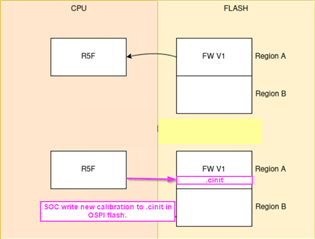Tool/software:
Hello,
In automotive development, it is common to "update the calibration" on an ECU, which is distinct from changing the application. In practice that is straightforward for a regular microcontroller with embedded flash. The application supporting XCP receives a HEX file over CAN and, together with flash drivers, erases and writes to the .cinit section to change the initialisation values of non-zero init variables. After reset, the new calibration is effectively active.
From a tool workflow perspective it looks like this: How to Use CANape to Flash Calibration Data to the ECU - KnowledgeBase - Vector Support
My problem is that I'm using AM263P4 without embedded flash. It loads an .appimage from OSPI flash. A small sub section of that .appimage must be the .cinit table but I don't know how to modify it by the application at run time.
<Question>
Can you give me some guidance on how to identify and modify only the .cinit sections of a multi-core .appimage residing in OSPI flash from the running application please?


